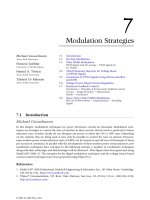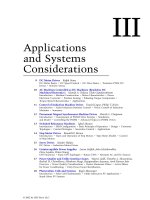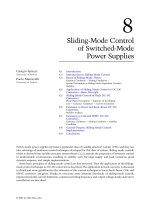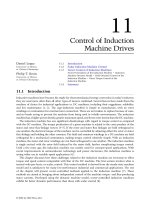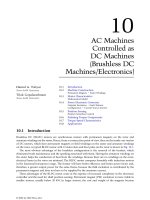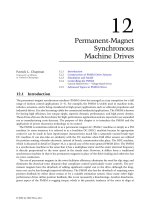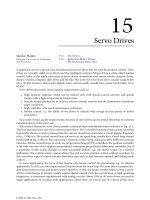Power Electronic Handbook P13
Bạn đang xem bản rút gọn của tài liệu. Xem và tải ngay bản đầy đủ của tài liệu tại đây (388.56 KB, 20 trang )
© 2002 by CRC Press LLC
13
Switched Reluctance
Machines
13.1 Introduction
Advantages • Disadvantages
13.2 SRM Configuration
13.3 Basic Principle of Operation
Voltage Balance Equation • Energy Conversion • Torque
Production • Torque–Speed Characteristics
13.4 Design
13.5 Converter Topologies
13.6 Control Strategies
Control Parameters
•
Advance Angle Calculation
•
Voltage-Controlled Drive
•
Current-Controlled
Drive
•
Advanced Control Strategies
13.7 Sensorless Control
13.8 Applications
13.1 Introduction
The concept of switched reluctance machines (SRMs) was established as early in 1838 by Davidson and
was used to propel a locomotive on the Glasgow–Edinburgh railway near Falkirk [1]. However, the full
potential of the motor could not be utilized with the mechanical switches available in those days. The
advent of fast-acting power semiconductor switches revived the interest in SRMs in the 1970s when Professor
Lawrenson’s group established the fundamental design and operating principles of the machine [2]. The
rejuvenated interest of researchers supplemented by the developments of computer-aided electromagnetic
design prompted a tremendous growth in the technology over the next three decades. SRM technology
is now slowly penetrating into the industry with the promise of providing an efficient drive system at a
lower cost.
Advantages
The SRM possess a few unique features that makes it a vigorous competitor to existing AC and DC motors
in various adjustable-speed drive and servo applications. The advantages of an SRM can be summarized
as follows:
• Machine construction is simple and low-cost because of the absence of rotor winding and per-
manent magnets.
• There are no shoot-through faults between the DC buses in the SRM drive converter because each
rotor winding is connected in series with converter switching elements.
Iqbal Husain
The University of Akron
© 2002 by CRC Press LLC
• Bidirectional currents are not necessary, which facilitates the reduction of the number of power
switches in certain applications.
• The bulk of the losses appear in the stator, which is relatively easier to cool.
• The torque–speed characteristics of the motor can be tailored to the application requirement more
easily during the design stage than in the case of induction and PM machines.
• The starting torque can be very high without the problem of excessive in-rush current due to its
higher self-inductance.
• The open-circuit voltage and short-circuit current at faults are zero or very small.
• The maximum permissible rotor temperature is higher, since there are no permanent magnets.
• There is a low rotor inertia and a high torque/inertia ratio.
• Extremely high speeds with a wide constant power region are possible.
• There are independent stator phases, which does not prevent drive operation in the case of loss
of one or more phases.
Disadvantages
The SRM also comes with a few disadvantages among which torque ripple and acoustic noise are the most
critical. The double saliency construction and the discrete nature of torque production by the independent
phases lead to higher torque ripple compared with other machines. The higher torque ripple also causes
the ripple current in the DC supply to be quite large, necessitating a large filter capacitor. The doubly
salient structure of the SRM also causes higher acoustic noise compared with other machines. The main
source of acoustic noise is the radial magnetic force induced resonant vibration with the circumferential
mode shapes of the stator.
The absence of permanent magnets imposes the burden of excitation on the stator windings and
converter, which increases the converter kVA requirement. Compared with PM brushless machines, the per-
unit stator copper losses will be higher, reducing the efficiency and torque per ampere. However, the
maximum speed at constant power is not limited by the fixed magnet flux as in the PM machine, and,
hence, an extended constant power region of operation is possible in SRMs. The control can be simpler
than the field-oriented control of induction machines, although for torque ripple minimization significant
computations may be required for an SRM drive.
13.2 SRM Configuration
The SRM is a doubly-salient, singly-excited reluctance machine with independent phase windings on the
stator, usually made of magnetic steel laminations. The rotor is a simple stack of laminations, without
any windings or magnets. The cross-sectional diagrams of a four-phase, 8-6 SRM and a three-phase, 12-8
SRM are shown in Fig. 13.1. The three-phase, 12-8 machine is a two-repetition version of the basic 6-4
structure within the single stator geometry. The two-repetition machine can alternately be labeled as a
4-poles/phase machine, compared with the 6-4 structure with two poles/phase. The stator windings on
diametrically opposite poles are connected either in series or in parallel to form one phase of the motor.
When a stator phase is energized, the most adjacent rotor pole-pair is attracted toward the energized
stator to minimize the reluctance of the magnetic path. Therefore, it is possible to develop constant torque
in either direction of rotation by energizing consecutive phases in succession.
The aligned position of a phase is defined to be the situation when the stator and rotor poles of the
phase are perfectly aligned with each other attaining the minimum reluctance position. The unsaturated
phase inductance is maximum (
L
a
) in this position. The phase inductance decreases gradually as the rotor
poles move away from the aligned position in either direction. When the rotor poles are symmetrically
misaligned with the stator poles of a phase, the position is said to be the unaligned position. The phase
has the minimum inductance (
L
u
) in this position. Although the concept of inductance is not valid for
a highly saturating machine like SRM, the unsaturated aligned and unaligned inductances are two key
reference positions for the controller.
© 2002 by CRC Press LLC
Several other combinations of the number of stator and rotor poles exist, such as 10-4, 12-8, etc. A 4-2
or a 2-2 configuration is also possible, but they have the disadvantage that, if the stator and rotor poles are
aligned exactly, then it would be impossible to develop a starting torque. The configurations with higher
number of stator/rotor pole combinations have less torque ripple and do not have the problem of starting
torque.
FIGURE 13.1
Cross sections of two SR machines: (a) four-phase, 8-6 structure; (b) three-phase, 12-8, two-repetition
structure.
(b)
(a)
A
D
C
B
A
D
CBs
Br
9
R0
R1
R2
B
R3
N
A
3
B
4
5
6
7
8
1
2
A
C
B
A
B
C
A
S
C
C
B
S
N
© 2002 by CRC Press LLC
13.3 Basic Principle of Operation
Voltage Balance Equation
The general equation governing the flow of stator current in one phase of an SRM can be written as
(13.1)
where
V
ph
is the DC bus voltage,
i
is the instantaneous phase current,
R
is the winding resistance, and
λ
is the flux linking the coil. The SRM is always driven into saturation to maximize the utilization of the
magnetic circuit, and, hence, the flux-linkage
λ
is a nonlinear function of stator current and rotor position
(13.2)
The electromagnetic profile of an SRM is defined by the
λ
–
i
–
θ
characteristics shown in Fig. 13.2. The
stator phase voltage can be expressed as
(13.3)
where
L
inc
is the incremental inductance,
k
v
is the current-dependent back-emf coefficient, and
ω
=
d
θ
/
dt
is the rotor angular speed. Assuming magnetic linearity (where
λ
=
L
(
θ
)
i
), the voltage expression
can be simplified as
(13.4)
FIGURE 13.2
Flux–angle–current characteristics of a four-phase SRM.
V
ph
iR
dl
dt
------
+=
lli, q()=
V
ph
iR
∂l
∂i
------
di
dt
-----
∂l
∂q
------
dq
dt
------
++ iR L
inc
di
dt
-----
k
v
w++==
V
ph
iR L q()
di
dt
-----
i
dL q()
dt
--------------
w++=
0 5 10 15 20 25 30 35 40
0
0.002
0.004
0.006
0.008
0.01
0.012
0.014
Phase Current in Amps.
Aligned Position
Unaligned Position
Flux-Linkage in V-Secs.
© 2002 by CRC Press LLC
The last term in Eq. (13.4) is the “back-emf ” or “motional-emf” and has the same effect on SRM as
the back-emf has on DC motors or electronically commutated motors. However, the back-emf in SRM
is generated in a different way from the DC machines or ECMs where it is caused by a rotating magnetic
field. In an SRM, there is no rotor field and back-emf depends on the instantaneous rate of change of
phase flux linkage.
In the linear case, which is always valid for lower levels of phase current, the per phase equivalent
circuit of an SRM consists of a resistance, an inductance, and a back-emf component. The back-emf
vanishes when there is no phase current or when the phase inductance is constant relative to the rotor
position. Depending on the magnitude of current and rotor angular position, the equivalent circuit
changes its structure from being primarily an
R
-
L
circuit to primarily a back-emf dependent circuit.
Energy Conversion
The energy conversion process in an SRM can be evaluated using the power balance relationship.
Multiplying Eq. (13.4) by
i
on both sides, the instantaneous input power can be expressed as
(13.5)
The first term represents the stator winding loss, the second term denotes the rate of change of magnetic
stored energy, while the third term is the mechanical output power. The rate of change of magnetic stored
energy always exceeds the electromechanical energy conversion term. The most effective use of the energy
supplied is when the current is maintained constant during the positive
dL
/
d
θ
slope. The magnetic stored
energy is not necessarily lost, but can be retrieved by the electrical source if an appropriate converter
topology is used. In the case of a linear SRM, the energy conversion effectiveness can be at most 50%
as shown in the energy division diagram of Fig. 13.3a. The drawback of lower effectiveness is the increase
in converter volt-amp rating for a given power conversion of the SRM. The division of input energy
increases in favor of energy conversion if the motor operates under magnetic saturation. The energy
division under saturation is shown in Fig. 13.3b. This is the primary reason for operating the SRM always
under saturation. The term
energy ratio
instead of efficiency is often used for SRM, because of the unique
situation of the energy conversion process. The energy ratio is defined as
(13.6)
FIGURE 13.3
Energy partitioning during one complete working stroke. (a) Linear case. (b) Typical practical case.
W
=
energy converted into mechanical work.
R
=
energy returned to the DC supply.
PV
ph
ii
2
RLi
di
dt
-----
1
2
--
i
2
dL
dq
------
w+
1
2
--
i
2
dL
dq
------
w++i
2
R
d
dt
-----
1
2
--
Li
2
1
2
--
i
2
dL
dq
------
w++== =
ER
W
WR+
---------------
=
unaligned
position
i
0
W
R
C
unaligned
position
λ
0
W
R
C
(a) (b)
λ
θ
aligned
position
aligned
position
© 2002 by CRC Press LLC
where
W
is the energy converted into mechanical work and
R
is the energy returned to the source using
a regenerative converter. The term energy ratio is analogous to the term power factor used for AC
machines.
Torque Production
The torque is produced in the SRM by the tendency of the rotor to attain the minimum reluctance
position when a stator phase is excited. The general expression for instantaneous torque for such a device
that operates under the reluctance principle is
(13.7)
where
W
′
is the coenergy defined as
Obviously, the instantaneous torque is not constant. The total instantaneous torque of the machine is
given by the sum of the individual phase torques.
(13.8)
The SRM electromechanical properties are defined by the static
T
–
i
–
θ
characteristics of a phase, an
example of which is shown in Fig. 13.4. The average torque is a more important parameter from the
user’s point of view and can be derived mathematically by integrating Eq. (13.8).
(13.9)
FIGURE 13.4
Torque–angle–current characteristics of a 4-phase SRM for four constant current levels.
T
ph
(q, i)
∂ W′ q, i()
∂q
------------------------
i=constant
=
W′ lq, i()id
0
i
∫
=
T
inst
q, i() T
ph
q, i().
phases
∑
=
T
avg
1
T
---
T
inst
td
0
T
∫
=
-30 -25 -20 -15 -10 -5 0 5 10 15
-0.5
0
0.5
1
1.5
2
2.5
3
3.5
Rotor Position in degrees
Phase A Phase B
Torque dip
Phase Torque in N.m
© 2002 by CRC Press LLC
The average torque is also an important parameter during the design process.
When magnetic saturation can be neglected, the instantaneous phase torque expression becomes
(13.10)
The linear torque expression also follows from the energy conversion term (last term) in Eq. (13.5).
The phase current needs to be synchronized with the rotor position for effective torque production.
For positive or motoring torque, the phase current is switched such that rotor is moving from the
unaligned position toward the aligned position. The linear SRM model is very insightful in understanding
these situations. Equation (13.10) clearly shows that for motoring torque, the phase current must coincide
with the rising inductance region. On the other hand, the phase current must coincide with the decreasing
inductance region for braking or generating torque. The phase currents for motoring and generating
modes of operation are shown in Fig. 13.5 with respect to the phase inductance profiles. The torque
expression also shows that the direction of current is immaterial in torque production. The optimum
performance of the drive system depends on the appropriate positioning of phase currents relative to the
rotor angular position. Therefore, a rotor position transducer is essential to provide the position feedback
signal to the controller.
Torque–Speed Characteristics
The torque–speed plane of an SRM drive can be divided into three regions as shown in Fig. 13.6. The
constant torque region is the region below the base speed
ω
b
, which is defined as the highest speed when
maximum rated current can be applied to the motor at rated voltage with fixed firing angles. In other
words,
ω
b
is the lowest possible speed for the motor to operate at its rated power.
Region 1
In the low-speed region of operation, the current rises almost instantaneously after turn-on, since the
back-emf is small. The current can be set at any desired level by means of regulators, such as hysteresis
controller or voltage PWM controller.
FIGURE 13.5
Phase currents for motoring and generating modes with respect to rotor position and idealized induc-
tance profiles.
Inductance at
constant current
u
c
a
Phase current,
i
ph
Unaligned
L
u
L
a
Motoring
Generating
Motoring
current
Generating
current
Current
increasing
Rotor position
Q
1
& Q
2
ON
D
1
& D
2
ON
Aligned
θ
θ
θ
θ
T
ph
q, i()
1
2
--
i
2
dL q()
dq
--------------
=
© 2002 by CRC Press LLC
As the motor speed increases, the back-emf soon becomes comparable to the DC bus voltage and it
is necessary to phase advance-the turn-on angle so that the current can rise up to the desired level against
a lower back-emf. Maximum current can still be forced into the motor by PWM or chopping control to
maintain the maximum torque production. The phase excitation pulses are also needed to be turned off
a certain time before the rotor passes alignment to allow the freewheeling current to decay so that no
braking torque is produced.
Region 2
When the back-emf exceeds the DC bus voltage in high-speed operation, the current starts to decrease
once pole overlap begins and PWM or chopping control is no longer possible. The natural characteristic
of the SRM, when operated with fixed supply voltage and fixed conduction angle
θ
dwell
(also known as
the dwell angle), is that the phase excitation time falls off inversely with speed and so does the current.
Since the torque is roughly proportional to the square of the current, the natural torque–speed charac-
teristic can be defined by T ∝ 1/
ω
2
. Increasing the conduction angle can increase the effective amps
delivered to the phase. The torque production is maintained at a level high enough in this region by
adjusting the conduction angle
θ
dwell
with the single-pulse mode of operation. The controller maintains
the torque inversely proportional to the speed; hence, this region is called the constant power region.
The conduction angle is increased by advancing the turn-on angle until the
θ
dwell
reaches its upper limit
at speed
ω
p
.
The medium speed range through which constant power operation can be maintained is quite wide
and very high maximum speeds can be achieved.
Region 3
The
θ
dwell
upper limit is reached when it occupies half the rotor pole-pitch, i.e., half the electrical cycle.
θ
dwell
cannot be increased further because otherwise the flux would not return to zero and the current
conduction would become continuous. The torque in this region is governed by the natural characteristics,
falling off as 1/
ω
2
.
The torque–speed characteristics of the SRM are similar to those of a DC series motor, which is not
surprising considering that the back-emf is proportional to current, and the torque is proportional to
the square of the current.
FIGURE 13.6 Torque–speed characteristics of an SRM drive.
p
b
#1
#2
#3
Rotor Speed (per Unit)
1 2
4
3
Torque (per Unit)
1
Constant
Torque Limit
Region
Constant
Power Limit
Region
Constant
Power*Speed
Limit Region
ω
ω

